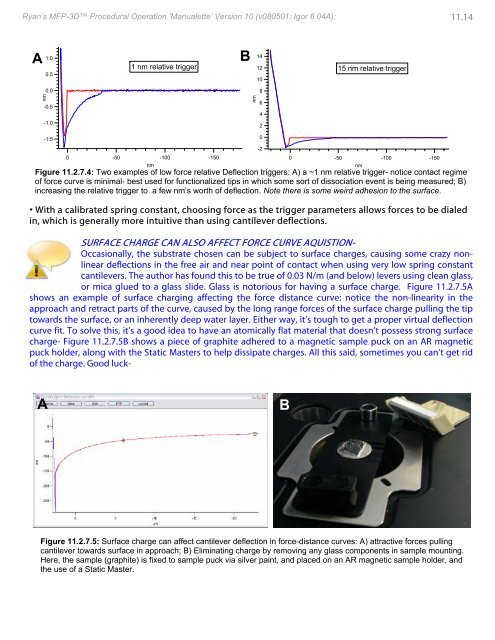B - St. Cloud State University
B - St. Cloud State University
B - St. Cloud State University
Create successful ePaper yourself
Turn your PDF publications into a flip-book with our unique Google optimized e-Paper software.
Ryan’s MFP-3D Procedural Operation ‘Manualette’ Version 10 (v080501; Igor 6.04A); 11.14<br />
A<br />
1.0<br />
0.5<br />
1 nm relative trigger<br />
B 14<br />
12<br />
10<br />
15 nm relative trigger<br />
0.0<br />
8<br />
nm<br />
-0.5<br />
-1.0<br />
nm<br />
6<br />
4<br />
2<br />
-1.5<br />
0<br />
-50<br />
nm<br />
-100<br />
-150<br />
Figure 11.2.7.4: Two examples of low force relative Deflection triggers: A) a ~1 nm relative trigger- notice contact regime<br />
of force curve is minimal- best used for functionalized tips in which some sort of dissociation event is being measured; B)<br />
increasing the relative trigger to a few nm’s worth of deflection. Note there is some weird adhesion to the surface.<br />
• With a calibrated spring constant, choosing force as the trigger parameters allows forces to be dialed<br />
in, which is generally more intuitive than using cantilever deflections.<br />
SURFACE CHARGE CAN ALSO AFFECT FORCE CURVE AQUISTION-<br />
Occasionally, the substrate chosen can be subject to surface charges, causing some crazy nonlinear<br />
deflections in the free air and near point of contact when using very low spring constant<br />
cantilevers. The author has found this to be true of 0.03 N/m (and below) levers using clean glass,<br />
or mica glued to a glass slide. Glass is notorious for having a surface charge. Figure 11.2.7.5A<br />
shows an example of surface charging affecting the force distance curve: notice the non-linearity in the<br />
approach and retract parts of the curve, caused by the long range forces of the surface charge pulling the tip<br />
towards the surface, or an inherently deep water layer. Either way, it’s tough to get a proper virtual deflection<br />
curve fit. To solve this, it’s a good idea to have an atomically flat material that doesn’t possess strong surface<br />
charge- Figure 11.2.7.5B shows a piece of graphite adhered to a magnetic sample puck on an AR magnetic<br />
puck holder, along with the <strong>St</strong>atic Masters to help dissipate charges. All this said, sometimes you can’t get rid<br />
of the charge. Good luck-<br />
0<br />
-2<br />
0<br />
-50<br />
nm<br />
-100<br />
-150<br />
A<br />
B<br />
Figure 11.2.7.5: Surface charge can affect cantilever deflection in force-distance curves: A) attractive forces pulling<br />
cantilever towards surface in approach; B) Eliminating charge by removing any glass components in sample mounting.<br />
Here, the sample (graphite) is fixed to sample puck via silver paint, and placed on an AR magnetic sample holder, and<br />
the use of a <strong>St</strong>atic Master.
















